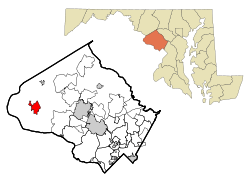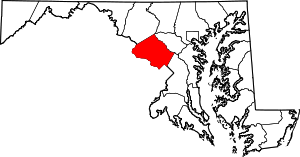Poolesville, Maryland
| Poolesville, Maryland | ||
|---|---|---|
| Town | ||
| Town of Poolesville | ||
| ||
| Motto: "Small Town Character, Down Home Charm!" | ||
 Location of Poolesville, Maryland | ||
| Coordinates: 39°8′26″N 77°24′30″W / 39.14056°N 77.40833°WCoordinates: 39°8′26″N 77°24′30″W / 39.14056°N 77.40833°W | ||
| Country |
| |
| State |
| |
| County |
| |
| Settled | 1760 | |
| Incorporated | 1867 | |
| Government | ||
| • Type | Board of Commissioners/Manager | |
| • President, Board of Commissioners | James Brown | |
| Area[1] | ||
| • Total | 10.23 km2 (3.95 sq mi) | |
| • Land | 10.18 km2 (3.93 sq mi) | |
| • Water | 0.05 km2 (0.02 sq mi) | |
| Elevation | 126 m (413 ft) | |
| Population (2010)[2] | ||
| • Total | 4,883 | |
| • Estimate (2012[3]) | 5,049 | |
| • Density | 479.7/km2 (1,242.5/sq mi) | |
| Time zone | EST (UTC-5) | |
| • Summer (DST) | EDT (UTC-4) | |
| ZIP code | 20837 | |
| Area code(s) | 240, 301 | |
| FIPS code | 24-62850 | |
| GNIS feature ID | 0593418 | |
| Website | http://www.poolesvillemd.gov | |
Poolesville is a town in the western portion of Montgomery County, Maryland. The population was 4,883 at the 2010 United States Census. It is surrounded by (but is technically not part of) the Montgomery County Agricultural Reserve,[4] and is considered a distant bedroom community for commuters to Washington, D.C.
The name of the town comes from the brothers John Poole, Sr. and Joseph Poole, Sr. who owned land in what is now Poolesville. Due to a historical anomaly, until 2010 the legal name of the town was "The Commissioners of Poolesville".[5] Residents overwhelmingly voted to formally change the name to "The Town of Poolesville" in the November 2010 general election.[6]
History
In 1760, brothers John Poole, Sr. and Joseph Poole, Sr. purchased 160 acres (0.65 km2; 0.25 sq mi) acres in the area that is now Poolesville. Thirty-three years later, John Poole, Jr. used a 15 acres (0.061 km2) tract that he inherited from his father to build a log store and subdivided the tract, selling portions to a number of other merchants. The settlement grew from there and was incorporated in 1867.[7]
During the Civil War Union military leaders realized that the shallow fords of the Potomac River posed a threat to the capital city. At certain times of the year the Potomac River is shallow enough to cross and thus thousands of troops were moved to both Darnestown and Poolesville. The Corps of Observation was established just outside Poolesville and soldiers were stationed near the river to watch for Confederate incursions into Maryland. During the winter of 1861-1862 it is estimated that 20,000 Union troops were stationed in or around the town. There were no battles fought in Poolesville; however, the infamous Battle of Ball's Bluff was fought nearby on October 21, 1861. Hundreds of Union soldiers who were stationed in Poolesville were killed in this battle that was badly managed by inexperienced Union generals.[8]
There were several Confederate raids into the town during the war and the Confederate Army invaded Maryland by crossing the Potomac near Poolesville in both 1862 and 1864. The old Poolesville Methodist Church cemetery contains the remains of approximately twenty soldiers who either were killed in action at Bulls Bluff or who died of illness while in camp.
The Seneca Schoolhouse, a small one-room schoolhouse of red sandstone, was built in Poolesville in 1866 to educate the children of the stone cutters who worked at the Seneca Quarry. Operating as the Seneca Schoolhouse Museum, it provides tours to schoolchildren so that they can experience a typical school day as it would have been on March 13, 1880.[9][10]
The Kunzang Palyul Choling Buddhist temple opened in Poolesville in 1985.[11]
The Poolesville Historic District was listed in 1975 on the National Register of Historic Places.[12]
Geography
Poolesville is located at 39°8′26″N 77°24′30″W / 39.14056°N 77.40833°W (39.140540, -77.408461).[13]
According to the United States Census Bureau, the town has a total area of 3.95 square miles (10.23 km2), of which, 3.93 square miles (10.18 km2) is land and 0.02 square miles (0.05 km2) is water.[1]
Poolesville lies off Montgomery County's main axis of suburban development along the Interstate 270 and Maryland State Route 355 corridor, separated from the contiguous Maryland suburbs of Washington by the rural lands of the county agricultural reserve, where new housing and commercial starts are restricted.
Government
Poolesville is governed by five commissioners elected in staggered 4-year terms. Commissioners are not paid. The commissioners elect among themselves a president (known informally as "the mayor") and vice president. A Town Manager is responsible for the day-to-day operations of the town. Six Boards and Commissions assist the commissioners: the Planning Commission, Parks Board, Board of Elections, Sign Review Board, Board of Zoning Appeals, and Ethics Commission.[14]
Demographics
| Historical population | |||
|---|---|---|---|
| Census | Pop. | %± | |
| 1900 | 236 | — | |
| 1910 | 174 | −26.3% | |
| 1920 | 325 | 86.8% | |
| 1930 | 197 | −39.4% | |
| 1940 | 204 | 3.6% | |
| 1950 | 161 | −21.1% | |
| 1960 | 298 | 85.1% | |
| 1970 | 349 | 17.1% | |
| 1980 | 3,428 | 882.2% | |
| 1990 | 3,796 | 10.7% | |
| 2000 | 5,151 | 35.7% | |
| 2010 | 4,883 | −5.2% | |
| Est. 2015 | 5,201 | [15] | 6.5% |
2000 census
As of the census[17] of 2000, there were 5,151 people, 1,601 households, and 1,402 families residing in the town. The population density was 1,333.8 people per square mile (515.2/km²). There were 1,630 housing units at an average density of 422.1 per square mile (163.0/km²). The racial makeup of the town in 2000 was 93.57% White, 2.85% African American, 0.49% Native American, 1.09% Asian, 1.4% from other races, and 1.28% from two or more races. Hispanic or Latino of any race were 2.68% of the population.
There were 1,601 households out of which 56.8% had children under the age of 18 living with them, 75.6% were married couples living together, 9.0% had a female householder with no husband present, and 12.4% were non-families. 9.3% of all households were made up of individuals and 2.0% had someone living alone who was 65 years of age or older. The average household size was 3.22 and the average family size was 3.44.
In the town the population was spread out with 35.0% under the age of 18, 5.6% from 18 to 24, 32.2% from 25 to 44, 24.0% from 45 to 64, and 3.2% who were 65 years of age or older. The median age was 35 years. For every 100 females there were 96.5 males. For every 100 females age 18 and over, there were 94.2 males.
The median income for a household in the town was $85,092, and the median income for a family was $88,916. Males had a median income of $60,596 versus $42,051 for females. The per capita income for the town was $30,211. About 2.5% of families and 2.6% of the population were below the poverty line, including 3.0% of those under age 18 and 7.5% of those age 65 or over.
2010 census
As of the census[2] of 2010, there were 4,883 people, 1,602 households, and 1,348 families residing in the town. The population density was 1,242.5 inhabitants per square mile (479.7/km2). There were 1,663 housing units at an average density of 423.2 per square mile (163.4/km2). The racial makeup of the town was 88.4% White, 5.2% African American, 0.5% Native American, 2.1% Asian, 1.4% from other races, and 2.5% from two or more races. Hispanic or Latino of any race were 7.0% of the population.
There were 1,602 households of which 45.4% had children under the age of 18 living with them, 71.0% were married couples living together, 8.8% had a female householder with no husband present, 4.4% had a male householder with no wife present, and 15.9% were non-families. 12.2% of all households were made up of individuals and 3% had someone living alone who was 65 years of age or older. The average household size was 3.04 and the average family size was 3.30.
The median age in the town was 41.5 years. 27.7% of residents were under the age of 18; 8.6% were between the ages of 18 and 24; 19.2% were from 25 to 44; 38.4% were from 45 to 64; and 6.1% were 65 years of age or older. The gender makeup of the town was 49.2% male and 50.8% female.
Education
Poolesville is served by Montgomery County Public Schools. Three schools are located in Poolesville: Poolesville High School , John Poole Middle School , and Poolesville Elementary School . Monacacy Elementary School in Dickerson also feeds into John Poole MS.
Notable people
- Thomas Plater, U.S. Congressman for Maryland's 3rd District, 1801–1805, died in Poolesville.[18]
References
- 1 2 "US Gazetteer files 2010". United States Census Bureau. Retrieved January 25, 2013.
- 1 2 "American FactFinder". United States Census Bureau. Retrieved January 25, 2013.
- ↑ "Population Estimates". United States Census Bureau. Retrieved June 26, 2013.
- ↑ Criss, Jeremy V. "Montgomery County's Agricultural Reserve and Agricultural Industry" (PDF). Archived from the original (PDF) on September 29, 2013. Retrieved 2015-10-11. This reference has a map of the Montgomery Country Agricultural Reserve; the Poolesville town limits are delineated by the white area inside the light green Agricultural Reserve portion of the map in western Montgomery County.
- ↑ http://www.monocacymonocle.com/images/MMVII_14_1-4.pdf,
- ↑ http://www.monocacymonocle.com/images/MMVII_17_1-4.pdf
- ↑ "A Brief History of Poolesville". Town of Poolesville - Charles W. Elgin Sr. Archived from the original on June 22, 2007. Retrieved July 14, 2007.
- ↑ Morgan, James A., III (2011). A Little Short of Boats: The Battle of Ball's Bluff and Edwards Ferry, October 21-22, 1861. El Dorado Hills, CA: Savas Beatie. ISBN 978-1611210668.
- ↑ Sheir, Rebecca (2015-03-20). "Kids Live History At One-Room Seneca Schoolhouse In Maryland". WAMU 88.5. Retrieved 2015-10-12.
- ↑ "Seneca Schoolhouse". Historic Medley District, Preserving the Historic Heritage of Western Montgomery County, Maryland. Retrieved 2015-10-12.
- ↑ Tierney, Meghan (2010-06-09). "Donors save Poolesville Buddhist temple". Gazette.net, Maryland Newspapers Online. Retrieved 2015-10-12.
- ↑ National Park Service (2008-04-15). "National Register Information System". National Register of Historic Places. National Park Service.
- ↑ "US Gazetteer files: 2010, 2000, and 1990". United States Census Bureau. February 12, 2011. Retrieved April 23, 2011.
- ↑ "Government of Poolesville - General Information". Town of Poolesville. Archived from the original on July 21, 2007. Retrieved July 14, 2007.
- ↑ "Annual Estimates of the Resident Population for Incorporated Places: April 1, 2010 to July 1, 2015". Retrieved July 2, 2016.
- ↑ "Census of Population and Housing". Census.gov. Retrieved June 4, 2015.
- ↑ "American FactFinder". United States Census Bureau. Retrieved January 31, 2008.
- ↑ "PLATER, Thomas, (1769 - 1830) - Biographical Information". United States Congress. Retrieved July 14, 2007.
